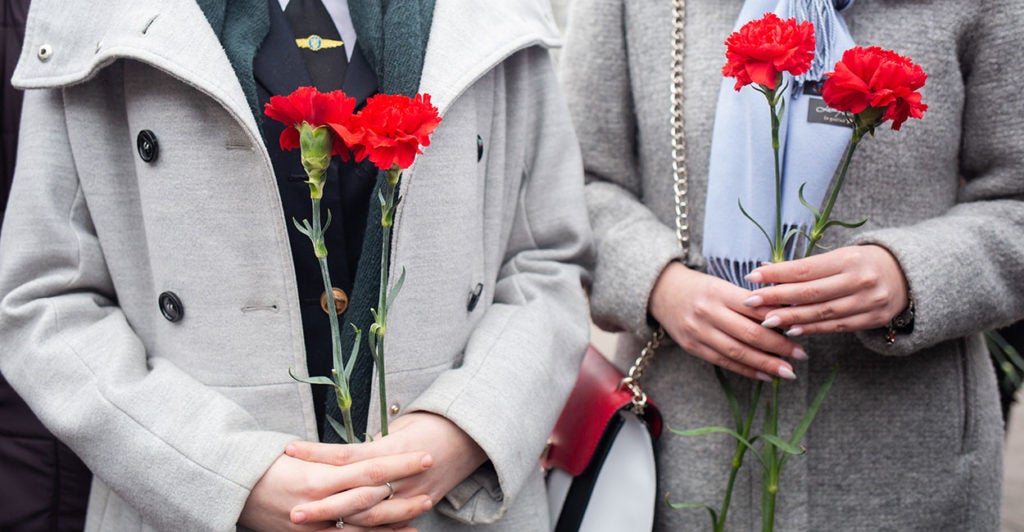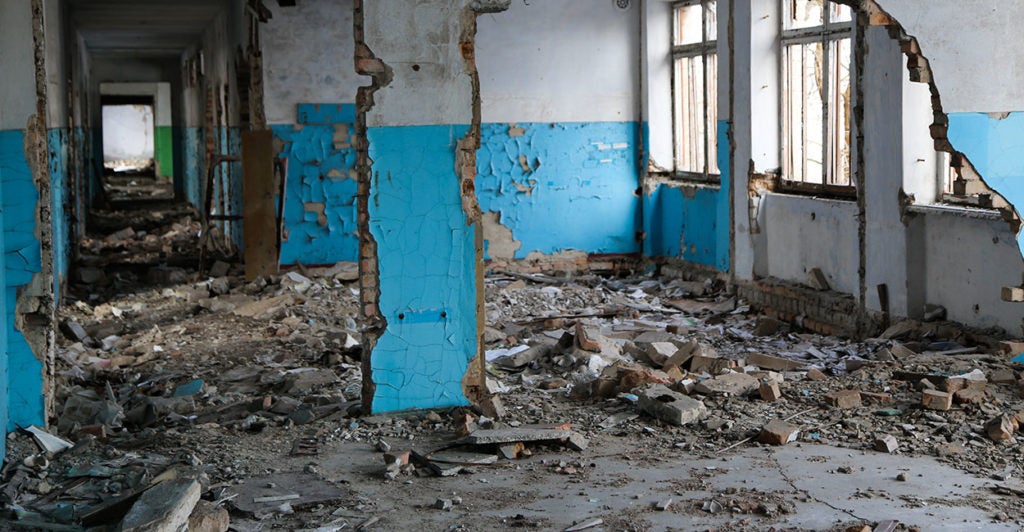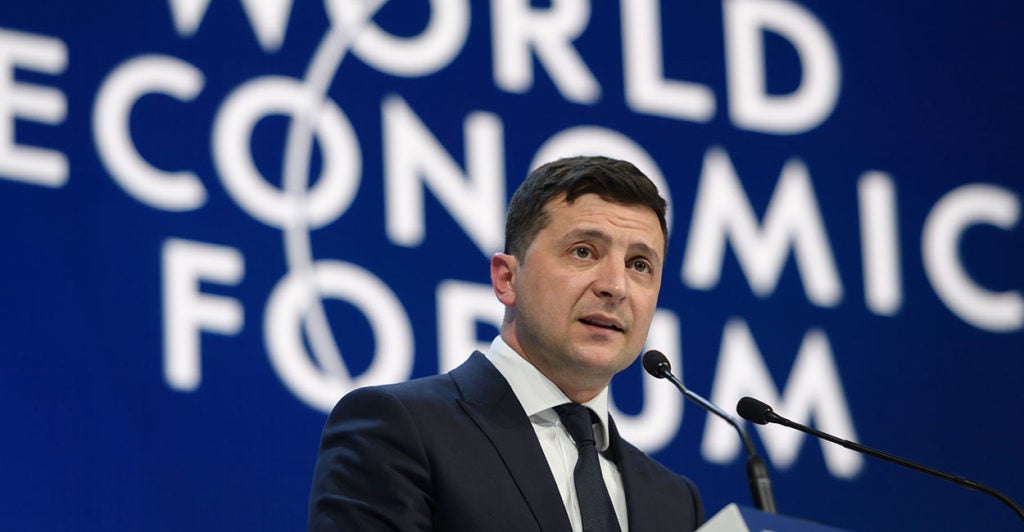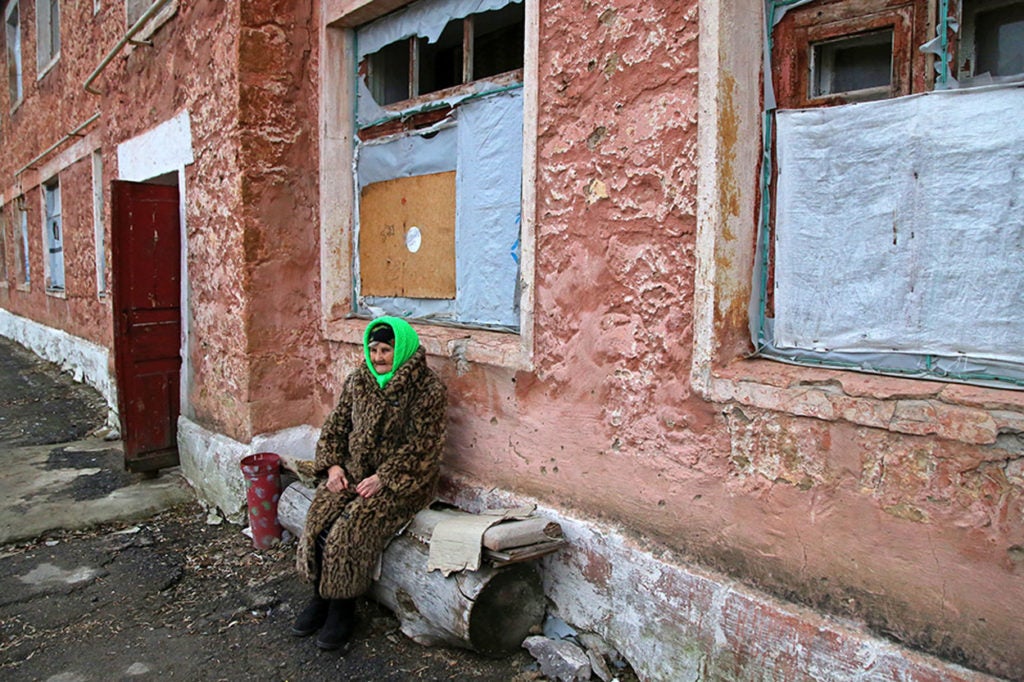Ukrainians Mark a Bittersweet Beginning to 2020
Nolan Peterson /
KYIV, Ukraine—The holidays are over and the winter doldrums have begun. For Ukrainians, the New Year has gotten off to a particularly bittersweet start, alternating between moments of monumental hope and tragedy.
The year began on an optimistic note. The closing days of 2019 saw a landmark prisoner exchange between Ukrainian and Russian forces, marking what many in Ukraine saw as the bellwether for rejuvenated peace talks after more than five years at war with their erstwhile Soviet ally.
Yet, that tepid optimism heading into the New Year was swiftly muted when Iranian surface-to-air missiles shot down a Ukrainian airliner outside Tehran on Jan. 8—only hours after Iran’s armed forces had fired a barrage of ballistic missiles at bases in neighboring Iraq housing U.S. troops.
All 176 passengers and crew aboard the Ukraine International Airlines 737 jetliner died in the crash. On Jan. 19, the bodies of the 11 Ukrainians killed returned to Ukraine in a somber ceremony at Kyiv’s Boryspil International Airport.

“Ukraine has incurred an irreparable loss … Our work will not stop until the circumstances of the tragedy are completely clear and those responsible are held liable,” Oleksiy Danilov, secretary of Ukraine’s National Security and Defense Council, wrote that day on Facebook.
The war, too, has taken a slight turn for the worse at the outset of 2020.
Ukraine’s military recorded 64 enemy attacks in the week from Jan. 13 to 19—a 64% jump from 39 enemy attacks the week prior. Also, four Ukrainian soldiers died in combat that week, up from one combat death the week prior, Kyiv reported.
“We grieve for the dead, but that does not prevent us from readying our weapons,” said Oleksandr Engel, a Ukrainian veteran.
Shadow of Impeachment
Looking forward to 2020, Ukraine’s outsize role in Washington’s impeachment drama has also worried many Ukrainians about the long-term durability of American military, economic, and diplomatic support, which has been a linchpin to their country’s defense against Russian aggression since 2014.
According to Ukraine’s lawmakers and troops, the country still heavily relies on both the symbolic and material value of American support to deter further Russian aggression.
“One way or another, I hope the United States continues to be our ally in the war against Russia. Otherwise, we can only die beautifully,” said Anatolii Stepanov, a Ukrainian conflict journalist and volunteer in support of Ukraine’s armed forces.
President Donald Trump’s temporary suspension of military aid to Ukraine last year did not spur increased aggression from Russia, as some had feared. Rather, Ukraine made significant progress toward peace with Russia in the time period after Trump’s controversial phone call with Ukrainian President Volodymyr Zelenskyy in July—the event at the heart of the Democrats’ impeachment case against Trump.
In December, for example, Zelenskyy and Russian President Vladimir Putin met in Paris for peace talks. It was the first meeting in three years for the so-called Normandy Format—a negotiating framework that dates back to 2014 to end the war in eastern Ukraine.
The Paris peace talks were a significant step toward a negotiated peace. At a minimum, the talks reopened channels of communication between Kyiv and Moscow through which trust can be slowly rebuilt, allowing incremental steps forward in hashing out compromises on controversial sticking points, such as holding elections in the Donbas.
The talks also signaled that both sides were looking for a diplomatic solution to the war, rather than victory through decisive military action.
Still, that peace process is still fragile and easily reversible—a fact shown by the recent spike in violence in the Donbas.
“Despite successive recommitments to the ceasefire, there are still frequent civilian casualties. This must stop,” said Edi Rama, chairperson-in-office of the Organization for Security and Cooperation in Europe, in a press release.
Also known as the OSCE, the Organization for Security and Cooperation in Europe is the multinational body charged with monitoring the cease-fire in eastern Ukraine.
“Our aim, first and foremost, must be to ensure a full and sustainable ceasefire,” Rama said in the press release. “In 2020, we will endeavour to improve the security situation and the daily lives of the people living in conflict-affected areas.”
Case Study in Failure
Russia invaded Ukraine’s eastern Donbas region in 2014, establishing two vassal breakaway territories dependent on Moscow for military and economic support.
Moscow had planned its Donbas operation for years, and many pieces were already in place before Ukraine’s 2014 “Revolution of Dignity,” in which protesters ousted the country’s corrupt, pro-Russian president at that time, Viktor Yanukovych.
More than 100 protesters died during the closing days of the revolution in February 2014.
“We gained freedom at an expensive price, but in 2014 Russia started a war in Crimea and in the east of Ukraine, trying to take away our independence,” said Pavlo Muroveiko, a Ukrainian war veteran.
In its early months, Russia’s hybrid offensive was on the march, leapfrogging across eastern Ukraine, taking town after town. Russian propaganda spun its invasion of the Donbas as a civil war led by disaffected Ukrainian separatists. But many Ukrainians clearly understood the conflict’s true nature and consequently feared a full-on Russian invasion. At the time, Kyiv’s metro was prepared for use as an underground bomb shelter.
Ukrainians rallied to their country’s defense, launching a grassroots war effort. A ragtag coalition of Ukrainian government troops and civilian militias soon gained the upper hand against Russia’s combined-separatist forces.

By July 2014, just three months into the conflict, Ukrainian forces had retaken 23 out of the 36 districts previously under combined Russian-separatist control. Then in August 2014, with its hybrid operation in shambles, Russia outright invaded eastern Ukraine with thousands of its own regular troops.
A February 2015 cease-fire, known as Minsk II, locked the war along its current front lines and moderated the intensity of combat by banning certain heavy weapons. However, the conflict never ended.
The war in the Donbas is now a static trench war. Over the years, Moscow has incrementally ratcheted up and down the level of violence in the Donbas as a means to exert political pressure on Kyiv. Albeit still lethal, the war has become a predictable daily exchange of artillery and sniper shots with neither side attempting to affect a breakthrough of its adversary’s lines or to take new ground.
So far, over 13,000 people have died in the Donbas war, and Kyiv’s troops continue to die at a rate of about 1 every 3 days. And civilians continue to get caught in the crossfire, too. The war has also displaced more than a million people from their homes. Europe’s only ongoing land war is also the Continent’s largest humanitarian crisis.
Yet, from an operational perspective, Russia’s original hybrid warfare plan in the Donbas was a failure, requiring the use of conventional military force to save face.
In a 2017 study, the Rand Corp. concluded that in eastern Ukraine Russia “failed to achieve the leverage necessary without resorting to conventional war and outright invasion.”
“Ukraine is a case study not in pioneering new nonlinear approaches but in the failure of hybrid warfare to deliver the desired political ends for Russia,” note the study’s authors.
Compromise Under Scrutiny
In the Minsk II cease-fire agreement, Moscow included controversial provisions that called on Ukraine to modify its constitution to divest power from Kyiv, as well as to hold elections in the contested Donbas territories.
Many Ukrainians worry that if the two Russian-controlled, so-called separatist territories in the Donbas are able to elect representatives for Ukraine’s national parliament, then Moscow will have acquired de facto voting rights in Ukraine’s government.
Such a scenario is a non-starter for many Ukrainians—especially those who braved sniper fire during the 2014 revolution to overthrow a corrupt president beholden to Moscow. Consequently, over the years Kyiv has seen a string of protests against the implementation of those controversial Minsk II cease-fire requirements.
An August 2015 protest outside Ukraine’s parliament—which was against the Minsk II cease-fire’s so-called decentralization measures—turned deadly when a Ukrainian combat veteran tossed a hand grenade at a riot control line. Several National Guard troops were killed.
More recently, a nonviolent “anti-capitulation movement” has formed across Ukraine, comprising a large number of war veterans who oppose Zelenskyy’s efforts to restart peace talks with Moscow by negotiating a way forward on holding elections in the Donbas.
“If we let elections go forward, it’s like we’re living in the Soviet Union all over again,” said Daniel Kovzhun, 43, a war veteran. “Yes, I’m totally against Zelenskyy’s plan. It’s a capitulation to Russia.”
A former comedian with no previous political experience, Zelenskyy billed himself as a political outsider committed to anti-corruption reforms and ending the war.

To that end, since assuming office in April the Ukrainian leader has made several bold peace overtures to Moscow to jump-start peace talks. Among those gambits, Zelenskyy has authorized the unilateral withdrawal of Ukrainian forces from some front-line positions. He also agreed in principle to hold elections in the Donbas—a longstanding Russian requirement to sit down for peace talks.
Zelenskyy was widely praised in Ukraine for holding his ground against Putin in Paris. Yet, the Ukrainian leader’s efforts to break the war’s stalemate have also spurred months of peaceful protests across Ukraine and the nationwide “anti-capitulation” movement.
“Zelenskyy does not have enough competence to conduct negotiations, all that he can do is sign a surrender,” said Muroveiko, the Ukrainian war veteran. “This is not the end of the war, but the surrender of our territories and our interests.”
Polling shows that many Ukrainians are reluctant to trust Russia. War veterans, in particular, have been outspoken in their opposition to Zelenskyy’s peace plans, demanding that he not hold elections in the Donbas until all Russian troops have left the contested territory.
“I’m totally against holding elections in the Donbas,” said 40-year-old Ukrainian war veteran Oleg Goltvyansky. “It’s a total betrayal of what I fought for.”
No Military Solution
In the Donbas, Ukrainian troops face a combined Russian-separatist force numbering some 34,000 soldiers, of which about 2,000 to 3,000 are Russian regulars, according to Ukrainian military officials. The remainder of that number comprises Ukrainian separatists and foreign mercenaries, Kyiv says.
Kyiv has rebuilt its once dilapidated military into a much more capable fighting force than when the war began in 2014. Kyiv’s newly reconstituted regular military wields the requisite firepower to take back the Donbas by force.
Yet, such an operation would certainly result in massive civilian casualties, experts say, and would also likely provoke the nearly 80,000 Russian troops deployed near Ukraine’s borders to intervene.
Consequently, many Ukrainian officials and front-line military commanders say there is no realistic military solution to the conflict. Diplomacy is the only way to end the war, they say. And that diplomatic effort ultimately depends on when the Kremlin loses its appetite for supporting the conflict.
“I don’t think there is such a plan [of Donbas liberation by force],” said David Arakhamia, a Ukrainian lawmaker and head of Zelenskyy’s Servant of the People political party, which holds a majority in Ukraine’s parliament, the Verkhovna Rada.
“All efforts of the past six months were aimed at a peaceful settlement exclusively,” Arakhamia told reporters at the World Economic Forum 2020 in Davos, Switzerland. “Moreover, we all must understand that there’s shooting every day, people die on both sides, so this is such a mix of a military situation and peaceful settlement efforts.”
Still, in order for Kyiv to maintain its negotiating leverage vis-à-vis Moscow, it must keep its troops on the front lines and under fire.
However, for many of those Ukrainian troops out in the trenches, their combat duty is of far greater importance to their country than simply maintaining diplomatic leverage. Many of those soldiers believe that if they simply packed up and went home, then Moscow’s forces would invade behind them all the way to Kyiv.
“Russians have killed many Ukrainians. Our soldiers, our women, our children. How can we trust them now?” said Goltvyansky, the war veteran.
War and Peace
Ukraine is no longer fighting an existential war for its survival like it was in 2014 or 2015. If Russia, at the war’s outset, intended to scuttle Ukraine’s chances of being a successful democracy or reversing the country’s Western pivot, then Russia’s original war plan has failed.
It’s true, the war remains a governor on Ukraine’s democratic progress, as well as a drain on the country’s economy, a detractor for foreign investment, and a political foil for some Ukrainian politicians who want to slow roll reforms.
However, Russia’s war has not strong-armed Ukraine into abandoning its desire to join NATO or the European Union one day. Nor has Ukraine strayed from its pro-democratic, anti-corruption trajectory.
By many measures, Ukraine has become a better democracy since the war began in 2014. Since then, the overall trajectory of Ukraine’s political and cultural evolution has steadily arced toward greater democratic freedoms, and a more just, transparent, and less corrupt system of government.
However, the disappointingly slow pace of that reformation helped pave the way for Zelenskyy’s landslide electoral victory last year over the incumbent president, Petro Poroshenko.
Recent polling suggests that a growing share of Ukrainians now believe their country is moving in the right direction. And, despite the war, Ukraine continues to be a democratic success story in the making.
For the most part, the controversial “de-centralization” measures ended up being a positive step for the country. Now, local governments have more control over their own spending, allowing them to follow through on community improvement projects long held up by red tape in Kyiv.
Thanks to funds freed up due to decentralization, the town of Horishni Plavni, for example, has gone an infrastructure improvement construction spree over the past few years.
The city has repaved its roads, built new roundabouts, sidewalks, streetlights, jogging paths, playgrounds, and cleared away overgrown plots of land.

Asserting Independence From Russia
On a more macro level, Ukraine’s national church in 2018 achieved independence from Moscow for the first time in centuries, marking what many Ukrainians saw as a historic step forward in the country’s ongoing cultural divorce from Russia.
In 2015, Ukraine passed sweeping “de-communization” laws that banned all vestiges of the Soviet Union. Since then, all statues of Vladimir Lenin have come down, and all cities and streets named after Soviet luminaries have been renamed.
Today, it’s technically illegal to fly the Soviet hammer and sickle flag or play the Soviet national anthem in Ukraine.
Since 2014, Ukraine has stopped all direct commercial air travel to Russia (although trains between the two countries still run), and China has replaced Russia as Ukraine’s top trading partner. Ukraine has also divested itself from relying on Russian gas for its winter heating needs.
The power of the Ukrainian passport has also improved. Ukrainians can now visit 128 countries without a visa, double the number of a decade ago. Of particular importance, Ukrainians can now travel throughout the EU without a visa.
That freedom to travel has afforded Ukrainians, particularly the younger generations, more exposure to other countries and cultures, spurring many to return home with higher expectations from their own government.
Last year, 15.1 million Ukrainians traveled abroad by airplane—a 30% jump from 2018, Ukraine’s Border Service reports.
Likewise, the number of tourists visiting Ukraine is also growing. In 2018, overall passenger traffic at Ukraine’s airports grew by 24.5%, reaching 20.5 million total passengers.
Last year, that number grew by another 18.5%, topping 24.3 million passengers through Ukraine’s airports.
However, that freedom to travel also has its downside. A recent census measured Ukraine’s population at 37.3 million—a 24% drop from 48.9 million in 2001.
Short life expectancies, a low birth rate, and the loss of territory during the war with Russia all contribute to that population decline, experts say. But so does emigration—particularly among young Ukrainians moving abroad for work.
Thus, a key challenge for Ukraine’s leaders moving forward in 2020 and the years to come will be to convince young people to stay in Ukraine and maintain their country’s incipient pro-democratic renaissance.
“The world must remember: Every next crippled generation is a path to a new war. Which is impossible, just impossible to win with victories,” Zelenskyy said in a speech last year before the United Nations General Assembly.
